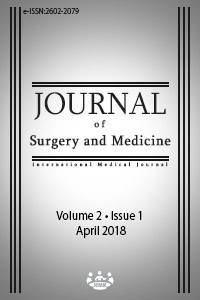A forgotten approach after cardiac arrest due to acute myocardial ınfarction: Neuroprotective therapeutic hypothermia
Abstract
In patients with spontaneous circulation after cardiopulmonary resuscitation, therapeutic hypothermia is defined as the reduction of body temperature to 32-34 ° C within the first 4-6 hours for neuroprotective purposes and to be maintained at this level for 12-24 hours after reaching the target temperature. Therapeutic hypothermia has been practiced since the 1940s. The aim of therapeutic hypothermia is to reduce cerebral edema, convulsive activity, metabolic demand and associated complications by providing low body heat. Therapeutic hypothermia is applied to increase life expectancy and quality of life. In out-of-hospital cardiac arrest, should be performed in comatose patients where initial rhythm is ventricular fibrillation and spontaneous circulation is returned. Herein, we present a 44 years old patient who had an aborted sudden cardiac death due to acute myocardial infarction and performing cardiopulmonary resuscitation for 30 minutes and discharged after 6 days with a successful therapeutic hypothermia.
References
- 1-Polderman KH. Induced hypothermia and fever control for prevention and treatment of neurological injuries. Lancet. 2008 Jun 7;371(9628):1955-69.
- 2- Laver S, Farrow C, Turner D, Nolan J. Mode of death after admission to an intensive care unit following cardiac arrest. Intensive Care Med (2004) 30:2126–2128.
- 3- M. Holzer, E. Cerchiari, P. Martens, R. Roine, F. Sterz, P. Eisenburge et al. Mild therapeutic hypothermia to improve the neurologic outcome after cardiac arrest. N Engl J Med 2002 May 30;346(22):1756.
- 4- Gebhardt K, Guyette FX, Doshi AA, Callaway CW, Rittenberger JC,Post Cardiac Arrest Service. Prevalence and effect of fever on outcome following resuscitation from cardiac arrest. Resuscitation. 2013;84:1062.
- 5- Arrich J,Holzer M, Havel C, Müllner M, Herkner H. Hypothermia for neuroprotection in adults after cardiopulmonary resuscitation. Cochrane Database Syst Rev 2012; 9:CD004128.
- 6-Wright WL, Geocadin RG. Postresuscitative intensive care: Neuroprotective strategies after cardiac arrest. Semin Neurol 2006; 26: 396-402.
- 7- John Bailitz, MD, Mark Hansen, MD, Mike Nelson, MD. Therapeutic Hypothermia in the Emergency Department .The Practical Journal of Emergency Phsycians. Emergency Medicine Reports 2009; 30(20):14.
- 8- Busto R, Globus MY, Dietrich WD, Martinez E, Valdes I, Ginnberg MD. Effect of mild hypothermia on ischemia-induced release of neurotransmitters and free fatty acids in rat brain. Stroke 1989;20:904-10.
- 9- Hypothermia after Cardiac Arrest Study Group; Holzer M. Mild therapeutic hypothermia to improve the neurologic outcome after cardiac arrest. N Engl J Med 2002; 346: 549-556.
- 10- Bernard SA, Gray TW, Buist MD, Jones BM, Silvester W, Gutteridge G, et al. Treatment of comatose survivors of out-ofhospital cardiac arrest with induced hypothermia. N Engl J Med 2002; 346: 557-563.
- 11- Nielsen N, Wetterslev J, Cronberg T, Erlinge D, Gasche Y, Hassager C, et al. Targeted Temperature Management at 33°C versus 36°C after Cardiac Arrest. N Engl J Med 2013; 369:2197.
- 12- Bernard S. Hypothermia after cardiac arrest: Ex¬panding the therapeutic scope. Crit Care Med2009;37:S227-33.
Akut miyokard infarktüsüne bağlı kardiyak arrest sonrası unutulan yaklaşım: Nöroprotektif terapötik hipotermi
Abstract
Kardiyopulmoner resisütasyon sonrası spontan dolaşım sağlanan hastalarda, nöroprotektif amaçlı ilk 4-6 saat içinde vücut ısısının 32-34 °C’ye kadar indirildiği ve hedef ısıya ulaştıktan sonra 12-24 saat bu düzeyde tutulmasına terapötik hipotermi denir. Terapötik hipotermi 1940’lardan bu yana uygulanmaktadır. Terapötik hipoterminin amacı, düşük vücut ısısı sağlayarak serebral ödem, konvülziyon aktivitesi, metabolik talebi ve bunlarla ilgili gelişecek komplikasyonları azaltmaktır. Terapötik hipotermi yaşam beklentisi ve hayat kalitesini artırmak için uygulanır. Hastane dışı kardiyak arrestlerde başlangıç ritmin ventriküler fibrilasyon olduğu ve spontan dolaşımın geri döndüğü komatöz hastalarda yapılmalıdır. Burada, akut miyokard enfarktüsü nedeniyle ani kardiyak ölümle sonuçlanan ve 30 dakika süreyle kardiyopulmoner resisütasyon uygulanan ve 6 gün sonra başarılı bir terapötik hipotermi sonrası taburcu edilen 44 yaşında bir hasta sunuyoruz.
References
- 1-Polderman KH. Induced hypothermia and fever control for prevention and treatment of neurological injuries. Lancet. 2008 Jun 7;371(9628):1955-69.
- 2- Laver S, Farrow C, Turner D, Nolan J. Mode of death after admission to an intensive care unit following cardiac arrest. Intensive Care Med (2004) 30:2126–2128.
- 3- M. Holzer, E. Cerchiari, P. Martens, R. Roine, F. Sterz, P. Eisenburge et al. Mild therapeutic hypothermia to improve the neurologic outcome after cardiac arrest. N Engl J Med 2002 May 30;346(22):1756.
- 4- Gebhardt K, Guyette FX, Doshi AA, Callaway CW, Rittenberger JC,Post Cardiac Arrest Service. Prevalence and effect of fever on outcome following resuscitation from cardiac arrest. Resuscitation. 2013;84:1062.
- 5- Arrich J,Holzer M, Havel C, Müllner M, Herkner H. Hypothermia for neuroprotection in adults after cardiopulmonary resuscitation. Cochrane Database Syst Rev 2012; 9:CD004128.
- 6-Wright WL, Geocadin RG. Postresuscitative intensive care: Neuroprotective strategies after cardiac arrest. Semin Neurol 2006; 26: 396-402.
- 7- John Bailitz, MD, Mark Hansen, MD, Mike Nelson, MD. Therapeutic Hypothermia in the Emergency Department .The Practical Journal of Emergency Phsycians. Emergency Medicine Reports 2009; 30(20):14.
- 8- Busto R, Globus MY, Dietrich WD, Martinez E, Valdes I, Ginnberg MD. Effect of mild hypothermia on ischemia-induced release of neurotransmitters and free fatty acids in rat brain. Stroke 1989;20:904-10.
- 9- Hypothermia after Cardiac Arrest Study Group; Holzer M. Mild therapeutic hypothermia to improve the neurologic outcome after cardiac arrest. N Engl J Med 2002; 346: 549-556.
- 10- Bernard SA, Gray TW, Buist MD, Jones BM, Silvester W, Gutteridge G, et al. Treatment of comatose survivors of out-ofhospital cardiac arrest with induced hypothermia. N Engl J Med 2002; 346: 557-563.
- 11- Nielsen N, Wetterslev J, Cronberg T, Erlinge D, Gasche Y, Hassager C, et al. Targeted Temperature Management at 33°C versus 36°C after Cardiac Arrest. N Engl J Med 2013; 369:2197.
- 12- Bernard S. Hypothermia after cardiac arrest: Ex¬panding the therapeutic scope. Crit Care Med2009;37:S227-33.
Details
| Primary Language | English |
|---|---|
| Subjects | Internal Diseases |
| Journal Section | Case report |
| Authors | |
| Publication Date | February 1, 2018 |
| Published in Issue | Year 2018 Volume: 2 Issue: 1 |


